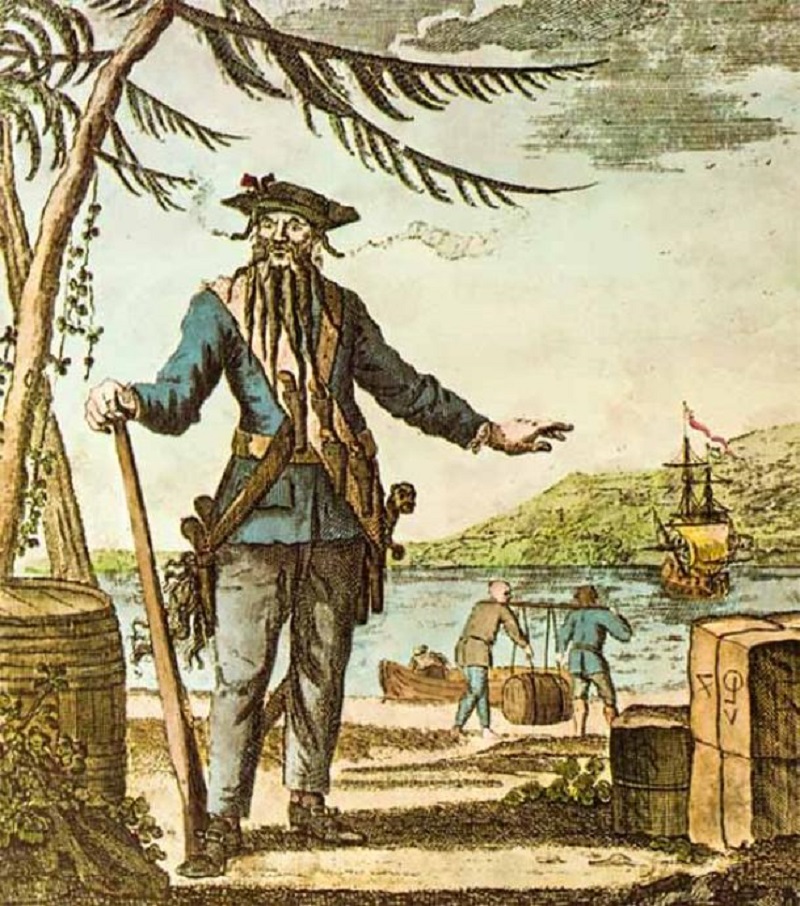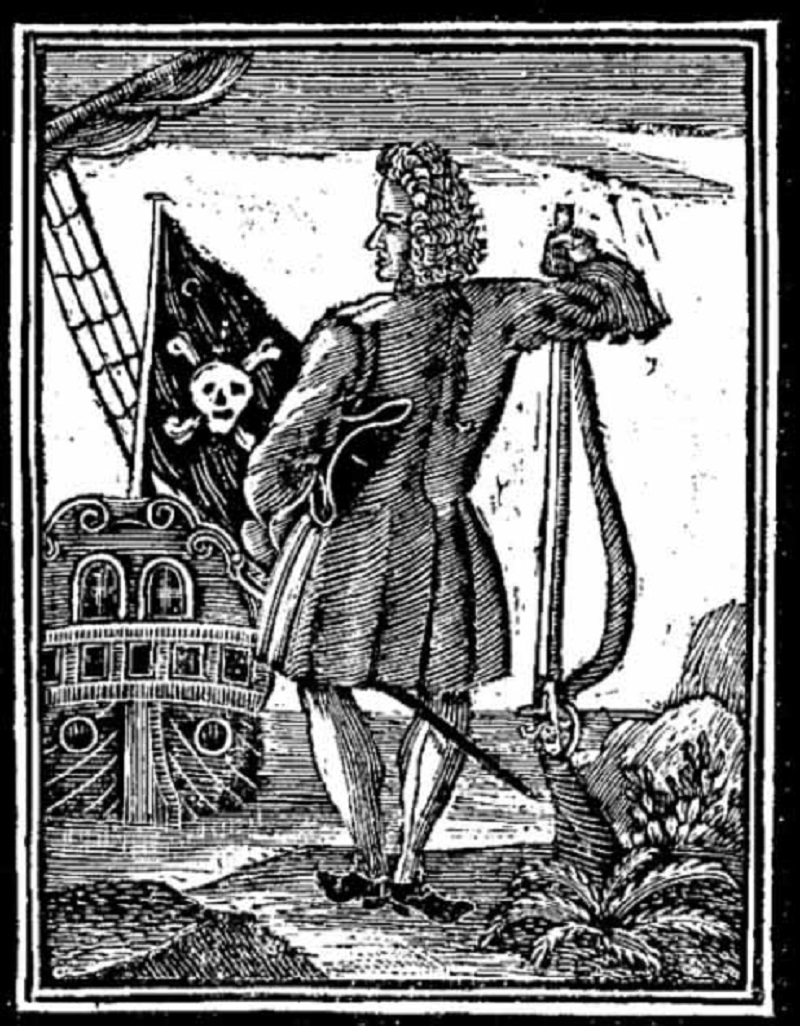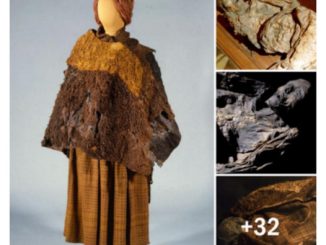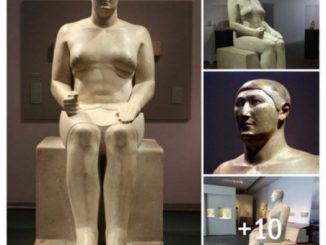Blackbeard, an infamous pirate from the 1700s, was notoriously an excellent fighter and survivalist. He was so famous, in fact, that after his death his skull was rumored to have been plated in silver and used as a punch bowl for decades. This skull bowl was supposedly passed around from place to place and used for parties, rituals, and even fraternity initiations.
But how did this scary pirate end up like a punch bowl in the first place? After years of being the most fearsome foe across the Atlantic, Blackbeard met with his final fate on Ocracoke Island off the coast of North Carolina. His head was placed on a pole and used as a warning to others. It was passed around until its supposed current home in a museum in Massachusetts. Its exact whereabouts throughout the last 300 years are uncertain, although there are many theories.
Edward Teach, commonly known as the pirate Blackbeard. (Public domain)
From Teach to Blackbeard: The Making of a Legendary Pirate
Originally known as Englishman Edward Teach (sometimes “Thatch”), Blackbeard was born around 1680 in Bristol. Unfortunately, not much is known about his young life. It is widely believed that he was educated early in life and that he had started his time on the sea as a sailor on a merchant vessel around Jamaica. At some point in the early 1700s, he decided to use his sailing and fighting skills to participate in the War of the Spanish Succession. Fighting for the British government, he fought Spanish ships in the West Indies to preserve their balance of power.
After the war, famous English pirate Benjamin Hornigold took an interest in Teach and let him join his crew. Hornigold typically operated his pirate out of New Providence, which was known as a famous safe haven for pirates. In 1716, Hornigold put Teach in command of a sloop (sailboat) he had recently captured. After preparing for nearly a year, Hornigold and Teach both set out from the safety of New Providence to find other ships and goods to capture. They were quickly successful, capturing several ships containing cargo such as flour and wine within a few months.
1725 woodcut of Stede Bonnet with a Jolly Roger. (Public domain)
Teach was so successful in his piracy that he quickly caught the eye of other Crews. That same year, Teach and Hornigold met Stede Bonnet, who had become a pirate a few months earlier. Bonnet confirmed in them that his 70-member crew was unhappy with his command, and decided to let Teach take over his crew as captain of Revenge. At this point, Teach and Hornigold traveled with all three ships as part of their fleet, and even added a fourth vessel just a few months later.
It is interesting to note that there is little to no record of Teach or Hornigold engaging in violence when capturing these ships. Hornigold is reported to have only attacked old enemies that attacked him first, while there is no record of violence in relation to Teach at all. Unfortunately, Hornigold’s Crews were not happy with his lack of violence, demoting him by the end of 1717. He took his original sloop and one other, leaving Teach with the other two. Teach and Hornigold never met again.
After parting ways, Teach quickly attacked a French vessel near Saint Vincent. This ship, called the Concord, was renamed Queen Anne’s Revenge and became Teach’s flagship vessel. The ship was equipped with 40 guns and a crew of over 300 men, and easily helped Teach take over a number of other ships. He used this ship for about a year before it was damaged beyond repair due to a sandbar off the coast of North Carolina, where it was left to sink.
Teach used his remaining ships to continue capturing and looting other ships. It is around this time that writers began to make note of his daunting physical appearance. They describe his long, black beard that seemed to cover his entire face, and how he took care of it by braiding it and twisting it with ribbons around his face.
Many historians believe that Blackbeard’s reputation as being ruthless and fearful is based on perception rather than actual evidence. There is currently no evidence that indicates that Blackbeard ever actually killed anyone. It is more likely that he used his powerful ships and physical appearance to intimidate others, which gave him his reputation as a vicious pirate.

The battle between Blackbeard the Pirate and Lieutenant Maynard in Ocracoke Bay in 1718. (Public domain)
The Infamous Downfall of Blackbeard
Teach’s downfall occurred in late 1718, when he took his ships to the coast of South Carolina and created a blockade. This blockade generated panic in the region, and also resulted in a significant amount of looting. After settling his issues with the locals, he then traveled up to North Carolina, where he asked Governor Charles Eden for a king’s pardon in return for giving up his piracy. Although some were surprised, this pardon was granted, and many believed this was the end of the infamous Blackbeard. They were unfortunately wrong.
In November 1718, Teach returned to pirate by capturing two French ships off the coast of Bermuda. These ships contain precious cargo including cocoa and sugar. When he returned with the ships to North Carolina, he convinced Governor Eden to declare one of them abandoned, which gave Teach legal access to the cargo. It is uncertain whether Eden was fully convinced the ship was simply “abandoned” at sea, or if he decided to collude with Teach in exchange for some of his loot. Regardless, this move made surrounding governors and lieutenants wary of Eden, and one decided to stop Blackbeard himself, without permission.
Lieutenant Governor Alexander Spotswood of Williamsburg, Virginia, decided to be the one to fix the Blackbeard problem. Fearing his colony would be looted, since they had more precious valuables than North Carolina, he had to move fast. Spotswood launched a raid on North Carolina which included a British naval force announced to advance on Teach’s ships.
Teach refused to submit to the ships, and not having any guns, the crews onboard had no choice but to fight Teach and his men with their own weapons. This was a risky move, as many had heard about Blackbeard’s skills in hand-to-hand combat, though none had seen it in person. Without cannons, though, they unfortunately had no choice.
Robert Maynard, a Virginian lieutenant leading the naval ships, decided to play a trick on Teach and his crew to give his men some leverage. During the fight, he commanded his men below deck to convince Teach that they were dead or had been thrown overboard. Once Teach fell for this and set foot on their ship to seize it, Maynard and his men rushed at Teach from below in a surprise attack.
Unprepared, Teach took several fatal blows before succumbing to his wounds and dying. It is recorded that at the time of his death, he had been shot five times and stabbings twenty. Because of the severity of his wounds, it is uncertain which of these was the final, fatal blow to Blackbeard.
Maynard had his men decapitate Blackbeard’s body and string his severed head from the bowspirit of Maynard’s ship. This display was a show of strength to the citizens of Virginia and North Carolina, especially to Governor Eden, whose reputation never fully recovered from his public relationship with Teach. After pulling into the port, Maynard stuck Teach’s head on a pole at the entrance of Chesapeake Bay, at Blackbeard’s Point on Hampton Creek, to warn other pirates to stay away from the region, lest they fall to the same fate as the infamous Blackbeard. The head remained on that pole for several years, until it was less than a decaying skull.
The pirate Blackbeard’s head hanging from the bowsprit. (Public domain)
Blackbeard’s Skull: Lost to the Sands of Time?
There are many stories about Blackbeard’s skull, some being based on fact and others pure fiction. The mythological tales of Blackbeard’s skull include stories of Blackbeard’s ghost wandering the Chesapeake Bay searching for his lost head. Others say that after he was decapitated, his body was thrown overboard where it circled the ship seven times before sinking. Unexplained light sightings have been reported around Chesapeake Bay, with locals calling the lights “Teach’s Light.”
More legitimate reports have claimed that Blackbeard’s skull was passed around from person to person for the last several hundred years once it was removed from its pole on the beach. Many claim that it was coated in silver to become a drinking bowl, which was used at dinner parties along the coast. The use of this bowl often leads to solemn discussions about pirates and their tragic, brutal fates on the eastern US coast. The skull was also reported to have been a central part of some fraternity rituals in the New England area. However, none of this has been fully confirmed.
Throughout the 1900s, the Blackbeard’s skull was supposedly in the possession of writer and collector Edward Rowe Snow, an author and historian from Massachusetts. In the 1990s, after his death, the skull was donated by his estate to the Peabody-Essex Museum in Salem, Massachusetts. Unfortunately, the skull is not on display at this museum. Because there is a significant lack of evidence proving that the skull indeed belongs to Blackbeard, they cannot in good faith display it as such. Some museums, such as the San Diego Maritime Museum, have borrowed the skull for temporary display, including of course a disclaimer about its uncertain origins.
It is unknown whether the skull will someday be on permanent display, or if more evidence will arise to clarify the origin of Blackbeard’s silver-plated skull. Records of the family that donated the skull only goes back so far, and the origin of the skull remains uncertain. Those who claim it’s the genuine article explain that there would be no point in faking that it’s Blackbeard’s skull, while those claiming it’s a fake say it’s simply wishful thinking. Whether it was preserved or lost to the sands of time, we may never know what happened to Blackbeard’s skull during the last 300 years. Perhaps his ghost finally found it after a long wandering on the Chesapeake Bay.





